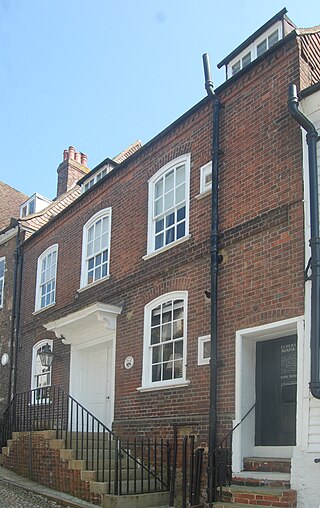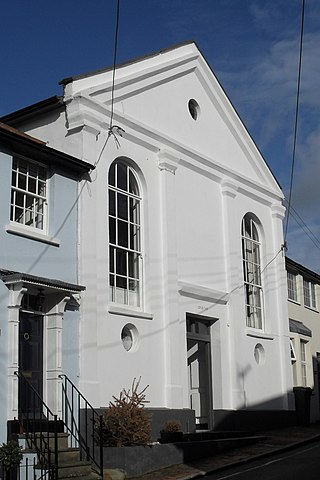
Broadmead is a street in the central area of Bristol, England, which has given its name to the principal shopping district of the city. It is part of Bristol Shopping Quarter.

Bristol, the largest city in South West England, has an eclectic combination of architectural styles, ranging from the medieval to 20th century brutalism and beyond. During the mid-19th century, Bristol Byzantine, an architectural style unique to the city, was developed, and several examples have survived.

Pontrobert is an ecclesiastical parish that was formed in September 1854. It comprises the townships of Teirtref and part of Nantymeichiaid in the parish Meifod, a portion of Cynhinfa which was in the parish of Llangynyw and portions of the townships of Fachwel, Llaethbwlch and Cadwnfa which were in the parish of Llanfihangel. The total area of this parish is 5,000 acres. As a result of this arrangement, Pont Robert is now divided between the present day Community Councils of Meifod, Llangyniew and Mawddwy. Pontrobert was within the historic county of Montgomeryshire, now forming part of Powys. The name Pontrobert is derived from Robert ap Oliver of Cyhinfa, who built the original bridge over the River Vyrnwy around 1700. An alternative Welsh name for Pontrobert is Pont y ddolfeiniog.

John Wesley's New Room is a historic building in Broadmead, Bristol, England. Opened in June 1739, it housed the earliest Methodist societies, and was enlarged in 1748. As the oldest purpose-built Methodist preaching house (chapel), it has been designated by Historic England as a Grade I listed building.

Quakers Friars is a Grade 1 Listed building in Broadmead, Bristol. Part of the former Blackfriars Priory site, it was used as a Quaker meeting house for nearly three hundred years, more recently serving as a registry office, a theatre, and a series of restaurants. It is an important site in both the early history of the Dominican Order in England and of the Religious Society of Friends (Quakers).

West Street Baptist Church is a Baptist church in East Grinstead, a town in the district of Mid Sussex, one of seven local government districts in the English county of West Sussex. Founded in 1810 as a chapel linked to the Countess of Huntingdon's Connexion, it was the first Nonconformist place of worship in East Grinstead; the town's subsequent development made it a local centre of both Protestant Nonconformity and alternative religions. The red-brick building is still used by a Baptist community, and is protected as a Grade II listed building.

Rye Particular Baptist Chapel is a former Strict Baptist place of worship in Rye, an ancient hilltop town in Rother, one of six local government districts in the English county of East Sussex. Built in the 18th century on the site of a decaying Quaker meeting house, it served Baptists in the town for many years until a new chapel was constructed nearby. The chapel is a Grade II Listed building.

Blackfriars, Bristol was a Dominican priory in Broadmead, Bristol, England. It was founded by Maurice de Gaunt in 1227 or 1228. Llywelyn ap Dafydd, son of Dafydd ap Gruffydd, the last native Prince of Wales, was buried in the cemetery of the priory. Following the Dissolution of the Monasteries in the 16th century, surviving parts of the priory became a guildhall for the Smiths and Cutlers Company, the Bakers Company, a workhouse and then Bristol Quaker meeting house. In the 20th century, it has housed the local register office, a theatre company, and a restaurant.

Jarvis Hall is a former Nonconformist chapel in the village of Steyning, in the Horsham district of the English county of West Sussex. Since its construction in 1835, the Classical-style building has been used by four different Nonconformist Christian denominations: the Countess of Huntingdon's Connexion, Wesleyan Methodists, the Salvation Army and Plymouth Brethren. The Brethren occupied it last and for the longest time. After about 150 years of religious use, it was sold for residential conversion. English Heritage has listed the former chapel at Grade II for its architectural and historical importance.

Horsham Unitarian Church is a Unitarian chapel in Horsham in the English county of West Sussex. It was founded in 1719 to serve the large Baptist population of the ancient market town of Horsham—home of radical preacher Matthew Caffyn—and the surrounding area. The chapel's congregation moved towards Unitarian beliefs in the 19th century, but the simple brick building continued to serve worshippers drawn from a wide area of Sussex. It is one of several places of worship which continue to represent Horsham's centuries-old tradition of Protestant Nonconformism, and is the town's second oldest surviving religious building—only St Mary's, the parish church, predates it. English Heritage has listed the chapel at Grade II for its architectural and historical importance.

Ditchling Unitarian Chapel is a Unitarian chapel in Ditchling, a village in the English county of East Sussex. A congregation of General Baptists began to meet in the 17th century in the village, which was a local centre for Protestant Nonconformist worship, and by the time the present simple Vernacular-style chapel was constructed in 1740 a large proportion of the population held Baptist beliefs. Along with other General Baptist chapels in Sussex, the congregation moved towards Unitarian views in the mid-18th century; this caused a schism which resulted in a new chapel being formed at nearby Wivelsfield. The character of the Ditchling chapel was wholly Unitarian by 1800, and it has continued under various names since then. People associated with the chapel include William Hale White, Henry Acton, Adrian Boult—who was married there—and G. K. Chesterton. The chapel is set back from Ditchling's main street and has an adjoining house and graveyard, all of which contribute to the character of the conservation area which covers the centre of Ditchling village. English Heritage has listed the chapel at Grade II for its architectural and historical importance.
Ronald Hubert Sims (1923–1999) was a British architect and artist. Influential in the Bournemouth area, he is best known for designing the Punshon Memorial Church which earned him the R.I.B.A. bronze medal in 1958. The church was demolished in 2015. In the 1960s, he designed the Broadmead Baptist Church in Bristol - it remains standing and is a fine example of Brutalist architecture.
The history of Quakerism in Sichuan began in 1887 when missionaries began to arrive from the United Kingdom. Missionaries founded schools and established meeting groups. Nonetheless, missionary activity in China generated controversy among many native Chinese and faced armed opposition during both the Boxer Rebellion and the later Chinese Communist Revolution. Although the former did not affect Sichuan so much as some other parts of China, the province was one of the hotbeds of anti-missionary riots throughout its ecclesiastical history.

Lewes Friends Meeting House is a Religious Society of Friends (Quaker) place of worship in the town of Lewes, part of the district of the same name in East Sussex, England. A Quaker community became established in the town in 1655 when George Fox, prominent Dissenter and founder of the Religious Society of Friends, first visited. A meeting house opened in 1675 and a burial ground was erected in 1697. The present meeting house, which is a Grade II listed building, was built in 1784 on the site of the burial ground. The building has undergone "a long and complex history of extensions" and rounds of alterations, including the addition of two cottages and a coach-house. It is one of a wide range of Protestant Nonconformist places of worship in the town, many of which have been established for centuries.












